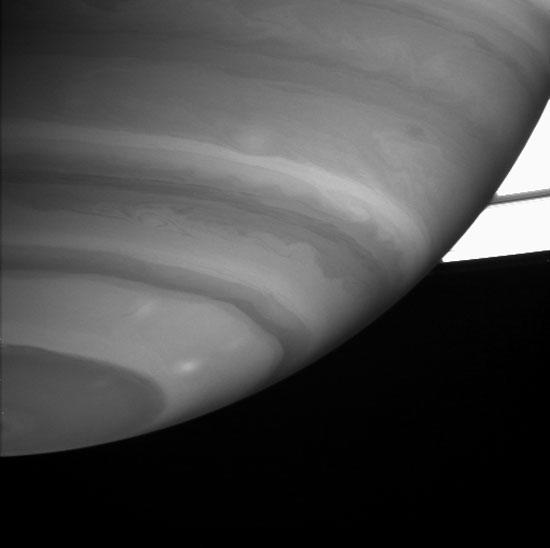This detailed view of Saturn's southern hemisphere shows clouds, storms and waves in the planet's many latitudinal bands.
At these wavelengths, gas in the atmosphere scatters sunlight more than the particles that make up the clouds, so the clouds look dark. This scattering of short-wavelength light by gas molecules is called Rayleigh scattering, and is the phenomenon that makes Earth's sky look blue.
The image was taken through a filter where methane gas has strong absorption. The cloud particles scatter light back toward the camera, but methane gas absorbs it, so only high clouds are visible in this image. Differences in cloud height are not resolvable; the impression of parallel ridges and troughs is an optical illusion brought about by the alternating light and dark bands.
Saturn's rings were overexposed in this long duration exposure and appear quite bright.
The image was taken with the Cassini spacecraft narrow angle camera on Sept. 12, 2004, at a distance of 8.7 million kilometers (5.4 million miles) from Saturn through a filter sensitive to wavelengths of infrared light centered at 889 nanometers. The image scale is 103 kilometers (64 miles) per pixel.
The Cassini-Huygens mission is a cooperative project of NASA, the European Space Agency and the Italian Space Agency. The Jet Propulsion Laboratory, a division of the California Institute of Technology in Pasadena, manages the Cassini-Huygens mission for NASA's Science Mission Directorate, Washington, D.C. The Cassini orbiter and its two onboard cameras were designed, developed and assembled at JPL. The imaging team is based at the Space Science Institute, Boulder, Colo.
For more information about the Cassini-Huygens mission, visit http://saturn.jpl.nasa.gov and the Cassini imaging team home page, http://ciclops.org .
Image Credit:
NASA/JPL/Space Science Institute

